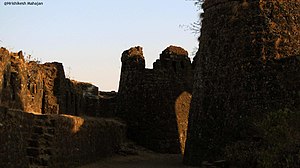Gawilghur
| Gawilghur | ||
|---|---|---|
|
Remnants of Gawilghur |
||
| Alternative name (s): | Gawilgarh, Gawilghar, Gawilgad | |
| Creation time : | 1425 | |
| Castle type : | Mountain fortress | |
| Conservation status: | Expired | |
| Construction: | stone | |
| Geographical location | 21 ° 23 '6 " N , 77 ° 20' 5.4" E | |
|
|
||
Gawilghur (also Gawilgarh , Gawilghar or Gawilgad ) was a strong mountain fortress of the Marathas, in the Indian province of Maharashtra north of the Deccan Plateau and close to the Melghat Tiger Reserve .
On December 15, 1803, the fortress was captured by British forces and units of the East India Company under Arthur Wellesley , later Duke of Wellington, during the Second Marathas . Until then, Gawilghur was considered impregnable because of its location on an inaccessible mountain peak.
history
The exact date of its construction is unknown. It is assumed, however, that a work made of earth and wood existed before the later fortress was built. In Persian records there is evidence that Ahmed Shah Wali from the Berar dynasty had Gawilghur built in the later form in 1425.
In 1803, at the end of the Second Marathas War, Gawilghur Fortress was besieged by forces under Arthur Wellesley. After building a road, the besiegers managed to get some artillery up on the mountain and break into the outer fort, which could then be captured. After the British troops tried twice in vain to capture the main gate of the inner fortress, but were repulsed with losses, Captain Campbell and the light company of the 94th Scottish Brigade managed to penetrate the inner fort with ladders. The company was able to fight its way through to the northern gatehouse and open the gates so that the rest of the troops could enter. This final attack was won with surprisingly few losses. After the peace agreement, Gawilghur was returned to the Marathas but never repaired.
particularities
Each of the fort's seven gates bears Persian inscriptions. Two large water reservoirs provided the garrison with supplies during sieges. The fortification consists of a smaller outer fort and a large inner fort, separated by a ravine. A mosque in the inner fort is still well preserved. The fortress can only be reached via two narrow paths that are in the firing range of the forts. A connecting tunnel is said to have existed between the fortress of Gawilghur and the fortress of Narnala , about 30 km away .
The breaches made by the British can still be seen today. An oversized cannon that killed five besiegers with one shot in 1803 has also survived.
Images of the fortress
Individual evidence
- ↑ Maharashtra Tourism Board website
- ^ The History of the British Empire in India, Publisher: Adamant Media Corporation (July 16, 2001), ISBN 0543803295
- ^ Historical and Descriptive Account of British India, from the most Remote Period to the Present, Publisher: BiblioBazaar (November 12, 2009), ISBN 1113939656
- ^ Wellington: The Iron Duke, Publisher: Harpercollins UK; Edition: New Ed (February 3, 2003), ISBN 0007137508
Web links
Media reception
Bernard Cornwell describes the siege of Gawilghur in his novel Sharpe's Fortress . The novel was filmed in 2008 under the title The Last Stand with Sean Bean in the lead role.




